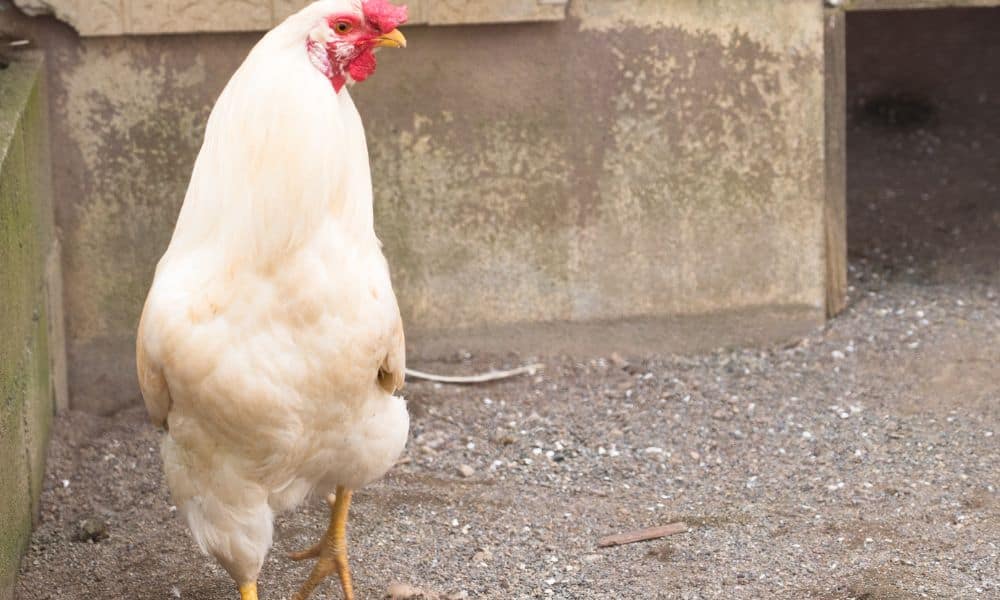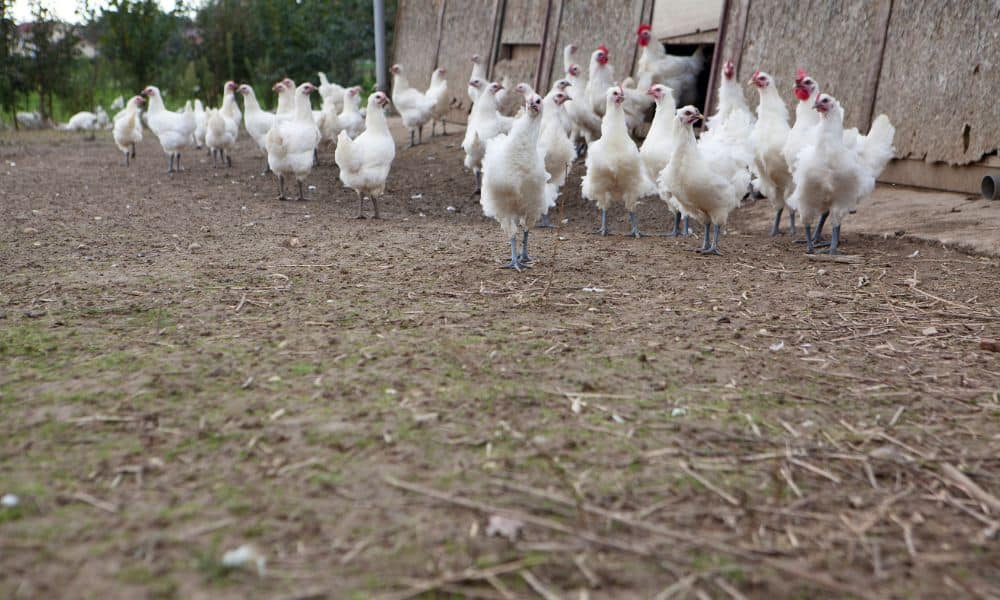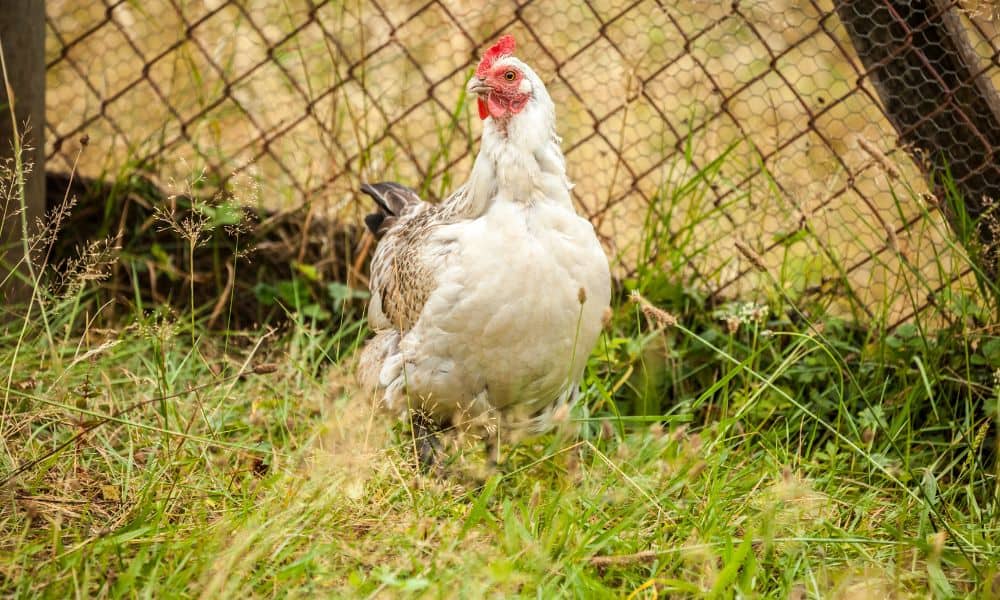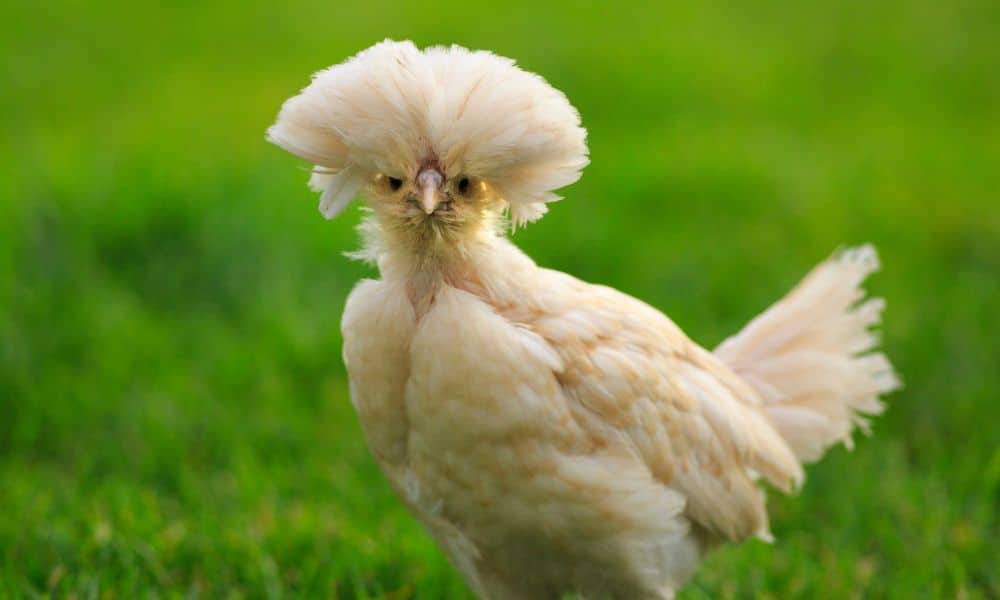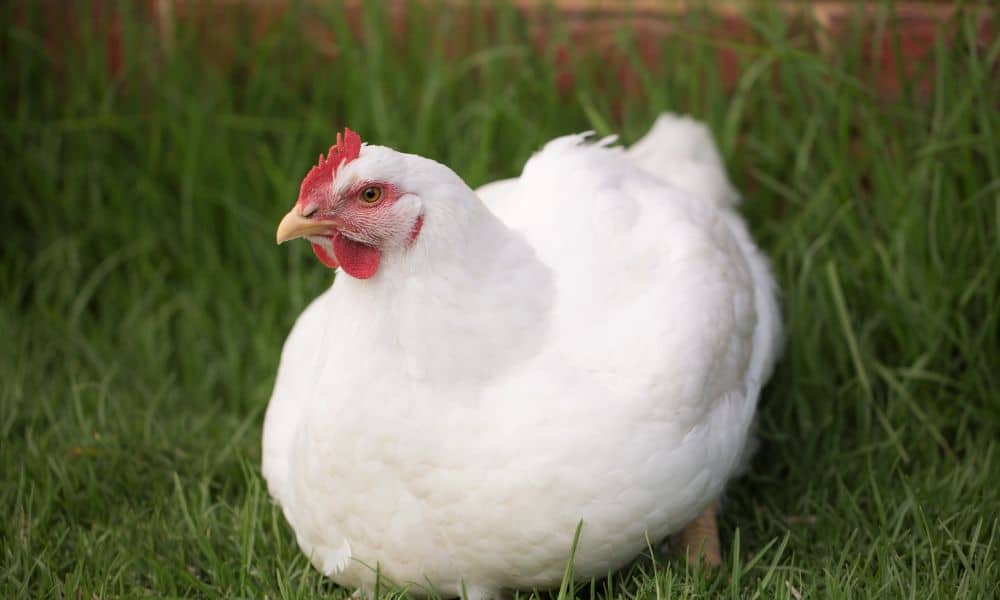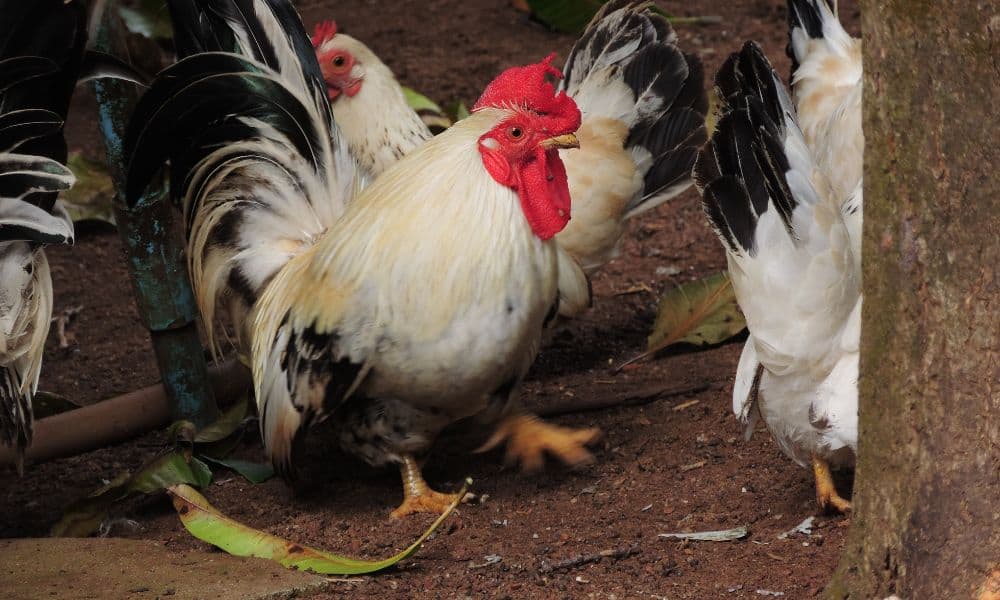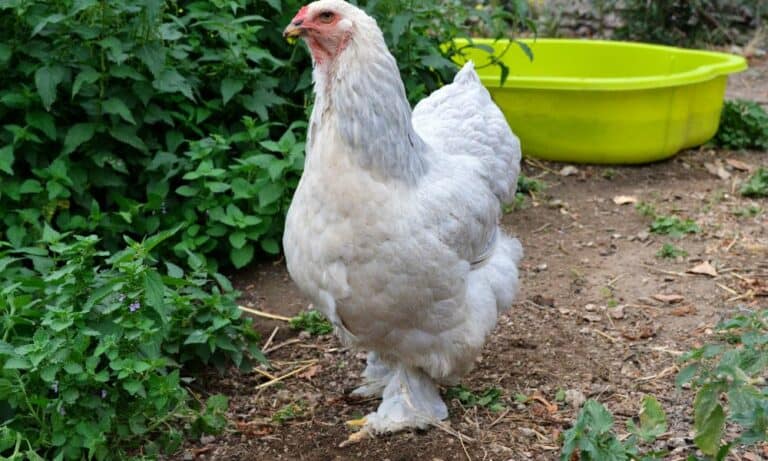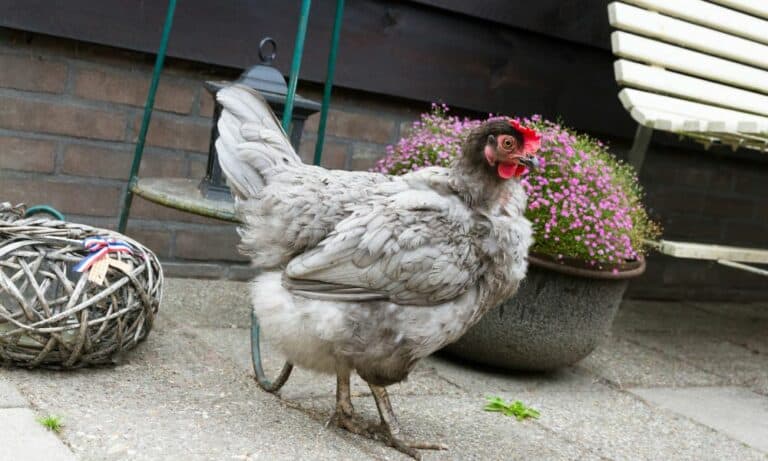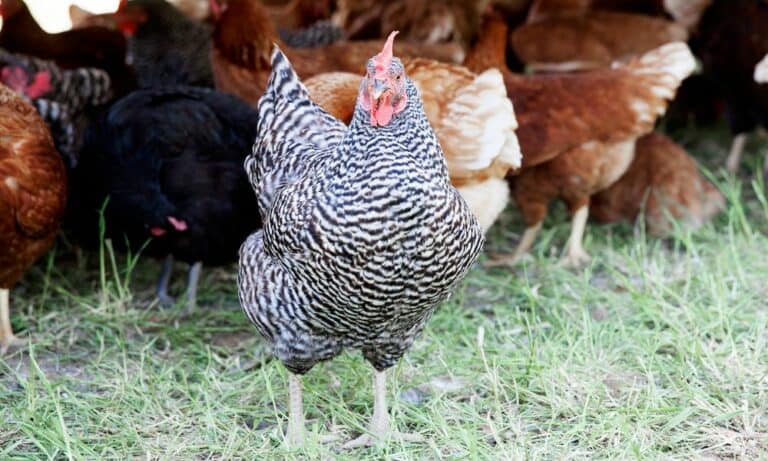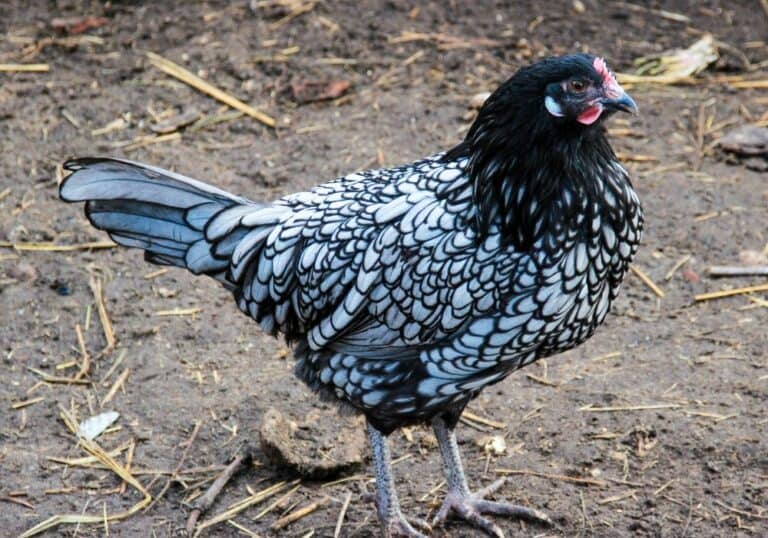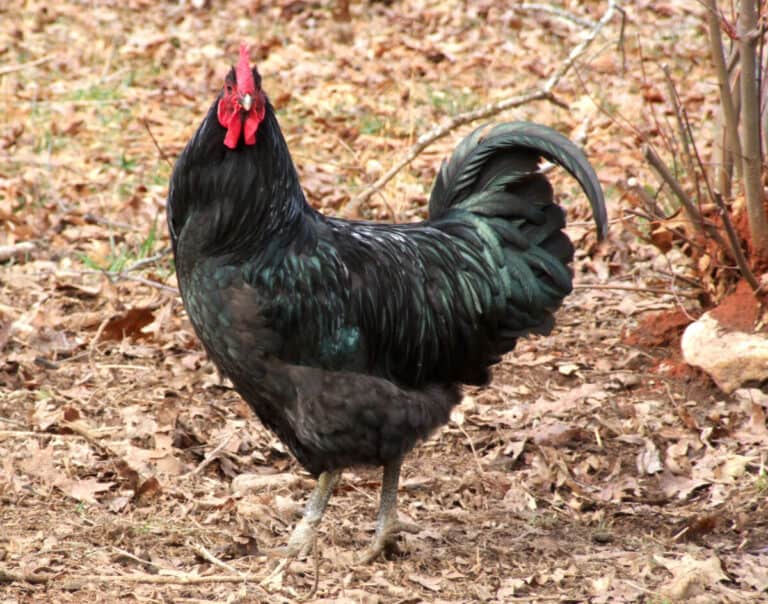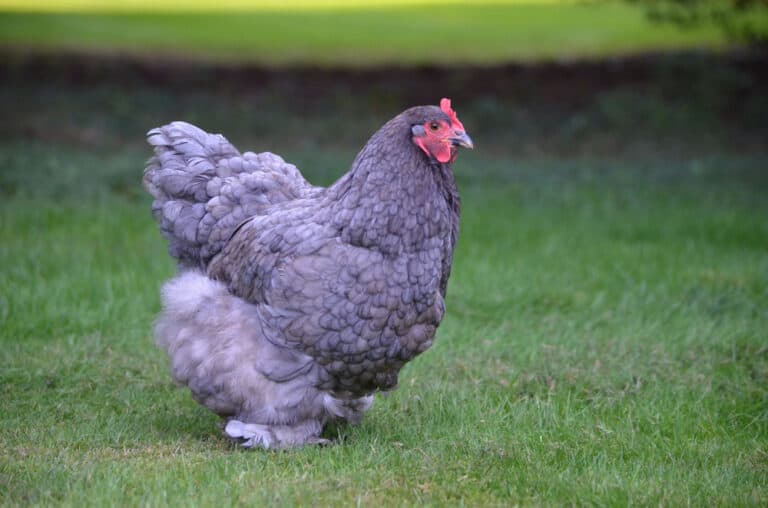Looking for a chicken that’s as white as snow? We’ve got you covered!
We’re going to look at 10 white chicken breeds from around the world. We’ll find out about their other characteristics, their temperaments, and how to keep them happy and healthy. And we’ll explore just how that pure white plumage developed too.
Ready to find out more? Then read on!
White Chicken Breeds
1. White Leghorn
The Leghorn originated from Italy, and it’s sometimes referred to as a Livorno or Livornese. Those alternative names come from the port of Livorno, from where the chickens were exported to the USA in 1828.
They are thought to have been developed from light colored breeds living in Tuscany. The first birds to cross the Atlantic were white, black and brown. The white were particularly popular, with White Leghorns taking first prize at a New York poultry show in 1868.
Today, different countries recognize different color varieties. In its native Italy, the Leghorn has can be one of ten colors, while the UK allows eighteen.
Whatever their color, Leghorn hens are known as good egg layers. They can produce anything from 180 to 250 eggs in a year – and those are white too.
They mature quickly too, and although they’re relatively small, they’re hardy birds. Standard adult males weigh between 5.3 and 7.5 pounds. Females are typically smaller, weighing between 4.4 and 5.5 pounds. There are also bantam Leghorns, which weigh around 2 pounds.
These are independently spirited chickens, who do best when allowed to roam free. They’re great foragers and can fly well too, often roosting in trees. But they don’t enjoy being picked up or cuddled, so they aren’t the right choice as a pet.
2. Bresse Gauloise
The Bresse Gauloise takes its name from the Bresse region of France where it originated.
The breed is believed to date back to the sixteenth century and has special status in France. Only chickens from that region are allowed to be referred to as Bresse. Chickens of the same breed born elsewhere are known as Gauloise.
There are four different color varieties: white, blue, black and gray. All of them have blue-gray legs and bright red combs. White chickens are known as Bresse de Bény, after a town in the area.
The hens are excellent layers, although in France, the breed is particularly prized for its meat. Hens will lay between 160 and 200 white eggs in the course of a year. These tend to be smaller when the hens first start laying, becoming larger as the bird matures.
They’re rather nervous birds by nature, and don’t relish too much interaction with humans. They do well with other chickens, though, and aren’t aggressive.
This is a breed that needs to be allowed to roam free. If kept confined, their health and well-being will suffer.
3. White Wyandotte
Wyandottes were developed in the 1870s, and were originally known as American Sebrights. Their modern name comes from the Wyandots, an indigenous people of North America.
The breed’s lineage is unknown, but it’s believed they’re descended from dark Brahmas and spangled Hamburgs.
They’re quite a large breed, with adult males weighing from 8 to 9 pounds, and females between 6 and 7 pounds. They have medium-sized bodies, broad backs, full breasts, and yellow legs.
The American Poultry Association recognizes nine different color varieties, including pure white. Those with snowy plumage are the result of a genetic mutation in silver-laced Wyandottes.
They’re another good choice if you’re looking for lots of eggs. Wyandotte hens typically lay about five eggs a week. They’re a good size too, with light brown or creamy colored shells which sometimes have speckles.
And somewhat unusually for such good layers, Wyandottes are good sitters too – in other words, they’ll incubate their eggs. And when they hatch, they’re attentive mothers.
They’re happiest when roaming free range and with other chickens of the same breed.
4. White Polish
Polish chickens can be found in a range of different color varieties. But the most typical plumage for these birds is pure white.
Despite their name, it’s unclear where these birds originated. Some people believe that it was in Poland, and that they are descended from Asian chickens brought to eastern Europe by the Mongols.
Others believe that they are really from the Netherlands, and the name comes from the Dutch word for “head”, pol. Polish chickens certainly do have a distinctive, dome-shaped head.
Their other characteristics include a small, red, v-shaped comb, small, bright red wattles, and white earlobes. But most striking of all is their large crest of feathers.
That crest is so large that it can cause these chooks some practical issues. By impairing their vision, they can easily be taken by surprise, so have developed a reputation for flightiness. And the feathers need to be kept scrupulously clean, or they can lead to eye and parasitic infections.
Polish chickens are primarily kept for exhibition purposes, hence the outsized crest. At one time, they were considered excellent egg layers. But with breeders concentrating on their appearance for showing, this trait has been diluted over the years.
5. White Rock
The Plymouth Rock is an American breed of chicken, first developed in the nineteenth century in Massachusetts. Those with solid white plumage are known as White Rocks.
They’re believed to have been bred from Dominiques and Javas, with possibly some Cochin genes in the mix too.
The result is a chicken with a bright red comb, wattles and earlobes, yellow legs, and a yellow or horn-colored beak. Young birds grow their feathers quickly, making them resistant to cold temperatures from a younger age than many other breeds.
Different breed associations around the world recognize different color varieties of Plymouth Rock. But while the barred plumage pattern was the original color, today all countries also recognize pure white chickens.
The hens lay around 200 eggs per year. Those eggs have brown shells and each weigh around 2 ounces.
6. Orpington
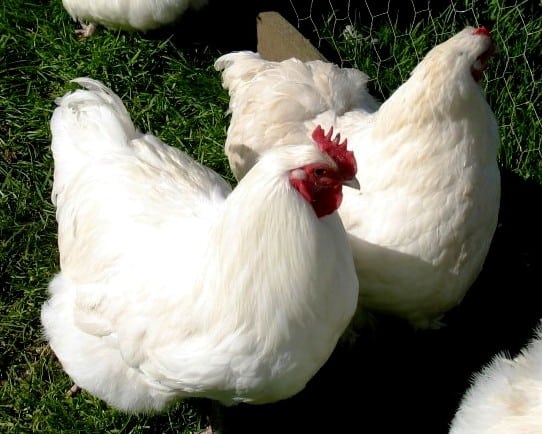
Orpington chickens originate from Kent in England, and take their name from the town where they first appeared.
Orpingtons can be found in a range of different color varieties, including solid white. In this breed, though, the gene for white plumage is recessive, which means that white birds are relatively rare.
Generally speaking, standard adult male Orpingtons weigh between 8 and 10 pounds, while females are between 6 and 8 pounds. The white plumage gene, however, is associated with slightly lower body weights.
There are also bantam Orpingtons, which, like their full-sized cousins, can be found with white feathers. These weigh between 3 and 3.5 pounds on average.
They’re striking birds, with curved backs, low bodies, and fluffy feathers. Breeders have tended to focus on enhancing these esthetic features for exhibition. But Orpington hens are nevertheless decent layers, producing around 175 to 200 medium to large eggs a year.
They’re friendly chooks too, and tend to be good with children.
7. Jersey Giant
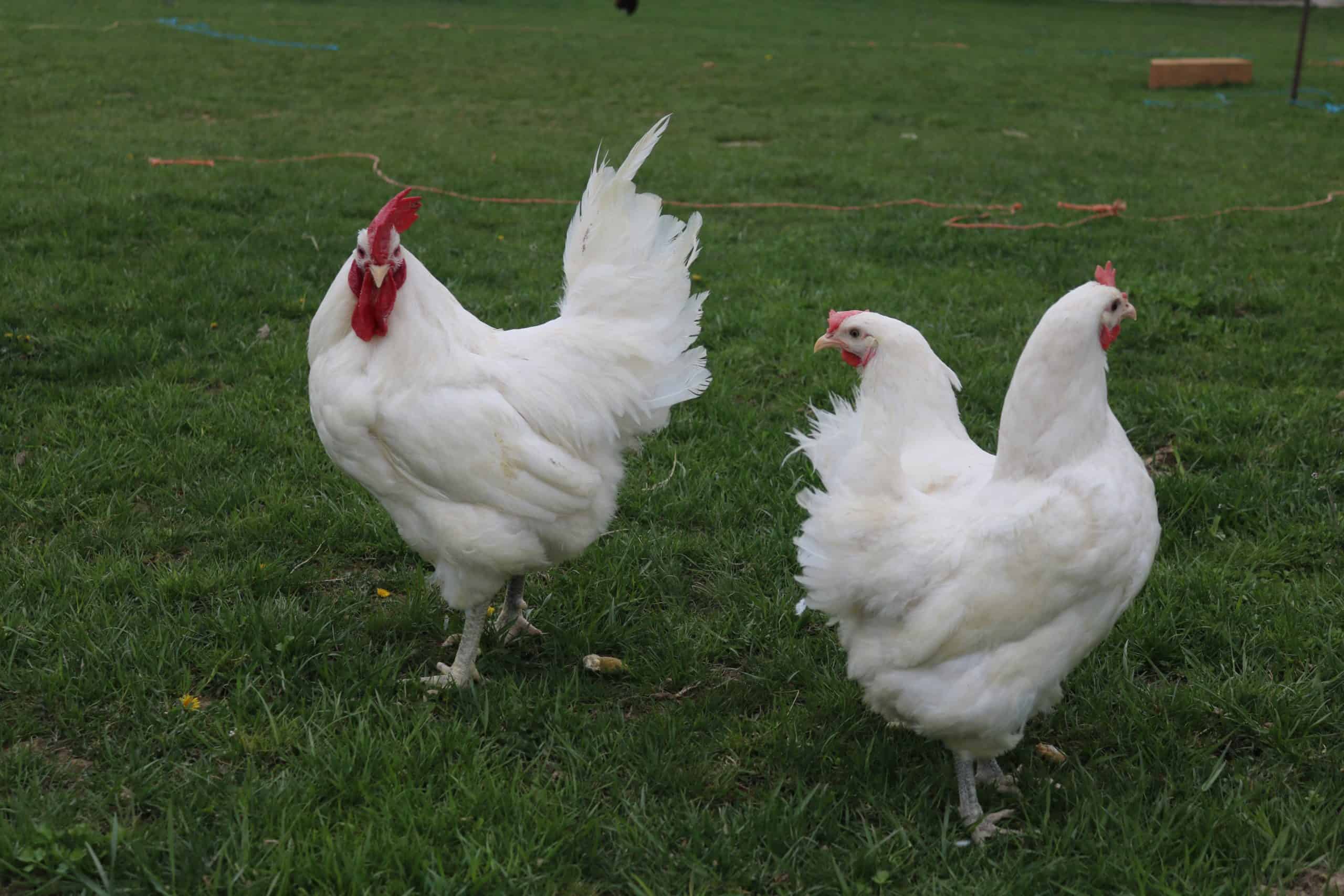
The Jersey Giant is most commonly found with black or blue plumage. But some Jerseys are solid white.
This American breed hails from Burlington County, in the state of New Jersey. And as you might expect from its name, it’s big! Adult males typically weigh around 13 pounds and females around 10 pounds. Even bantam Jersey Giants are usually around the 2-pound mark.
This is another case where the white plumage gene is associated with smaller birds. White Jersey Giants are an average of a pound lighter than their black counterparts.
They need both time and plenty of food to reach their full size, so they’re not the cheapest chooks to raise. But they’re calm and good natured, with even cocks rarely showing signs of aggression.
Their size makes them relatively able to withstand colder temperatures, although they’ll still need good shelter. And the hens continue laying their tasty brown eggs throughout the winter.
They’re good sitters too, and will happily incubate the eggs of other breeds. And when the chicks hatch, they make good moms as well.
8. Rhode Island White
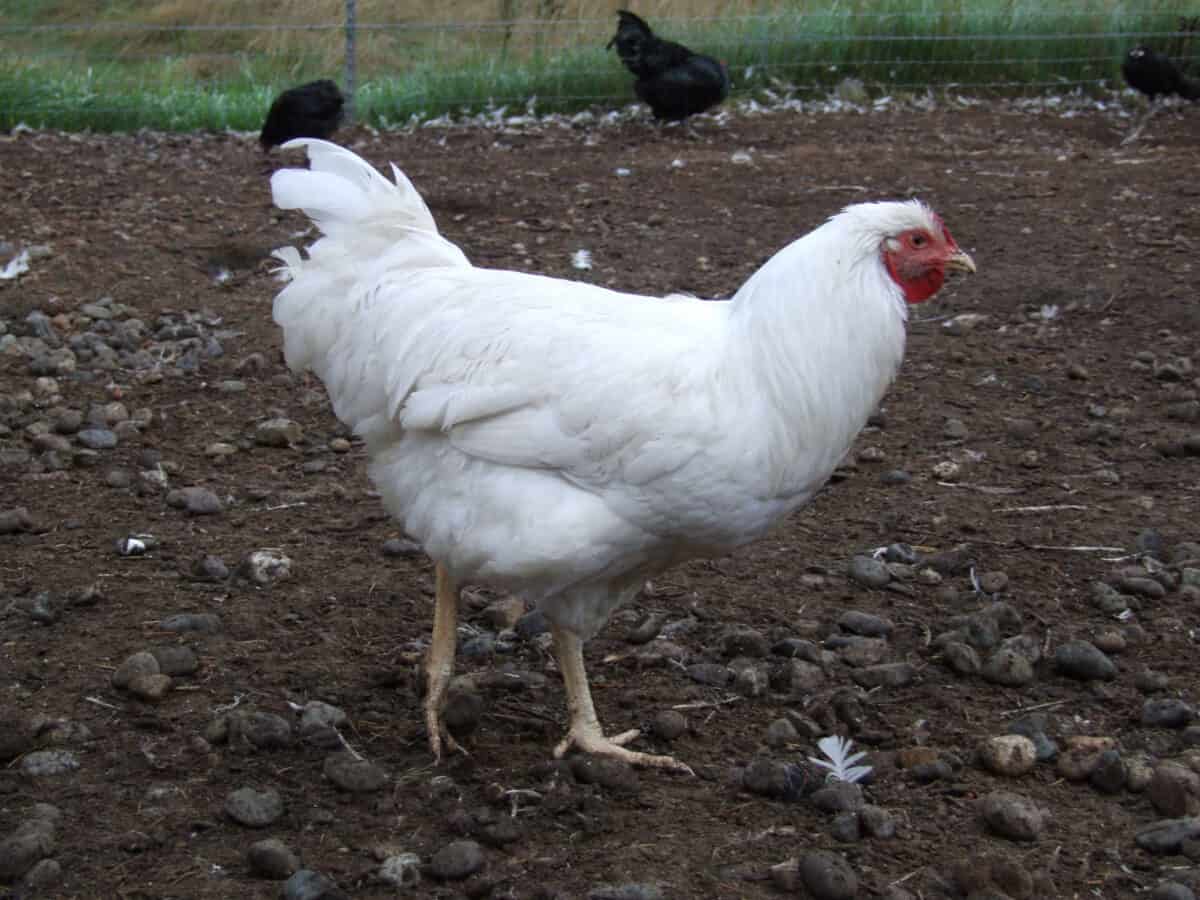
The Rhode Island Red might be better known, but there’s also a separate, pure white breed known as the Rhode Island White.
It was developed by a breeder named J. Alonzo Jocoy, who lived in Peacedale. Jocoy crossed White Leghorns, Partridge Cochins and White Wyandottes, and the first Rhode Island Whites emerged in 1903. The breed was popular until the 1960s, but is relatively rare today.
Standard adult males weigh around 8.5 pounds, while adult females are generally a couple of pounds lighter. There’s also a bantam variety, with males weighing around 34 ounces and females 30 ounces.
Their lovely white feathers are accompanied by yellow legs and beaks. They have medium sized wattles and red earlobes. And they have a rectangular body that’s similar in shape to that of Rhode Island Reds.
They’re friendly and sociable chooks, and the hens are good layers. They’ll start laying from around 6 months old, and will produce four or five eggs a week on average. And they’re hardy too, keeping laying throughout the winter.
They’re not great sitters, though. So if you’d like to breed from your Rhode Island Whites, you’ll need hen from a broodier breed or a cabinet incubator.
They’ll tolerate a good range of temperatures, although, like all chickens, they’ll need both shelter and shade. But while they’re more cold hardy than many breeds, the single comb variety is prone to frostbite. A radiant heater in the coop will avoid that unpleasant and painful problem.
9. Dorking
For Dorking chickens, solid white plumage is the most typical color variety. The other shades are silver-gray, red, dark and cuckoo.
The Dorking originates in the UK and takes its name from the Surrey town where it first appeared. It’s one of the oldest of all British breeds, and is thought to trace its lineage back to Roman chickens.
Cocks weigh between 10 and 14 pounds, cockerels between 8 and 11 pounds, and hens between 8 and 10 pounds.
The breed is unusual in that it has five toes instead of four. (The Romans believed five-toed chickens to be the best to breed from.) And it has a single comb, which, like that of the Rhode Island White, can be vulnerable to frostbite in cold weather.
It’s one of only a handful of breeds with red earlobes that produces eggs with white shells. The hardy hens will keep laying through winter. But while they’ll produce lots of eggs for a while, they tend to go broody after every 35 to 50 eggs.
That means they’ll want to incubate the eggs and hatch chicks, calling a halt to production. They are good sitters, though, and take good care of their young. And they can also often be persuaded to incubate the eggs of other breeds.
10. Minorca
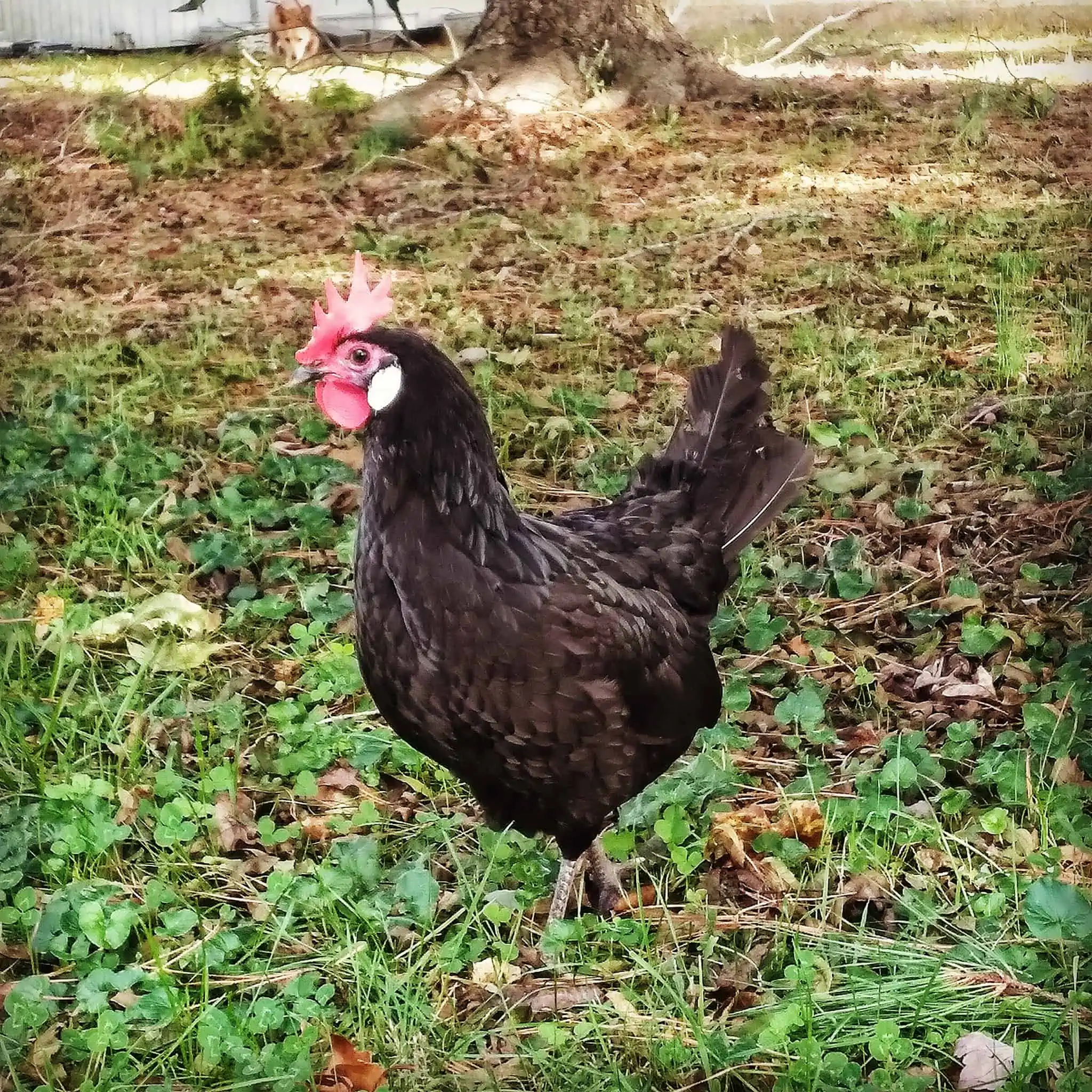
The Minorca chicken originated on the island of Menorca. But it was the British, occupying the island in the eighteenth century, who developed the breed from native Menorcan birds.
Since then, the Minorca has spread around the world as a popular bird in poultry exhibitions. Sadly, however, numbers have been in decline on its native island. In recent years, breeding programs have been launched in the hope of reversing that trend.
All Spanish Minorcas are black. But you’ll find white Minorcas (as well as blue ones) in the UK. The white plumage gene is recessive in this breed, however, so white birds are rarer than black.
In all colors, Minorcas have red faces, combs and wattles, and large white earlobes. The comb is smooth and has six points.
Although its striking looks mean it’s often kept as an ornamental bird, Minorca hens make good layers. While not particularly prolific – they produce about 120 eggs a year – they start laying early, from around 26 weeks old.
And as the hens mature, those eggs get bigger. Hens of 56 weeks and above will regularly lay eggs weighing more than 2.3 ounces.
Whiter than white
That brings us to the end of our look at ten white chicken breeds. In some of these, white is the most common color. In other cases, it’s a rarer variety.
If you’re planning on keeping chickens, research the breeds you’re interested in carefully before you commit. Different breeds – whatever their color! – have different needs and preferences. Match those to what you can provide, and you’ll be rewarded with happy, healthy chooks.

